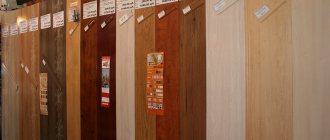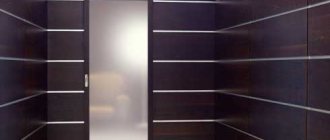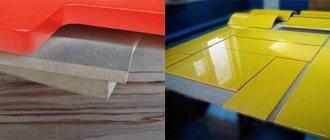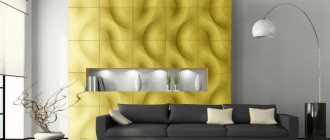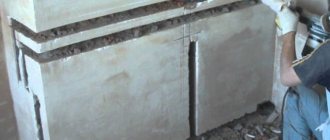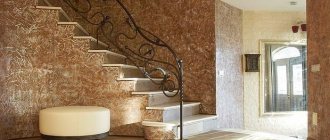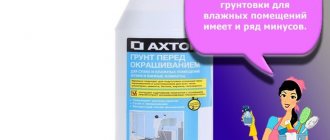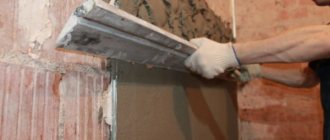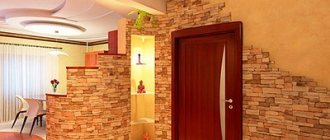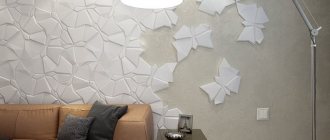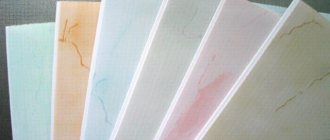Proper finishing of premises
An alternative to plastering is gypsum boards or particle boards.
Such materials are mounted directly on the surface or on a previously constructed frame. The latter option allows you to obtain additional space, which can be used for laying thermal insulation and communications. Without proper preparation, it is impossible to achieve high-quality results when decorating premises.
- Cleaning work. These are procedures that serve to obtain high-quality decorative coating. For this stage, the existing requirements are least stringent if the work is carried out independently.
SNP requirements for finishing residential premises
Among the documents entirely devoted to the regulation of redevelopment in Moscow, one can name Moscow Government Resolution No. 508, as amended by No. 840-PP. It establishes framework rules for registration, registration, design and delivery of finished redevelopments. At the same time, one of its requirements is (clause 11.9. Appendix 1) a ban on “violation of the requirements of construction, sanitary and hygienic, operational standards and fire safety rules for apartment buildings.”
6.4.3. If the source of EMR is household appliances located (or intended) for use inside residential premises, the assessment of its impact on humans is carried out in accordance with the requirements of current sanitary standards for acceptable levels of physical factors when using consumer goods in domestic conditions. In this case, the measurement of potentially harmful factors should be carried out in the area where people are as close as possible to household appliances in accordance with the instructions for their use. If such information is not available, then when taking measurements you must be guided by the following:
Interior decoration
Naturally, this is only a small part of all the documents that are used when designing the interior decoration of houses and apartments. For almost every operation there is a separate GOST, SNiP or instructions that will help you understand the nuances of the work.
Types of interior decoration
All finishing work can be divided into 5 large categories:
- rough finishing;
- electrical installation;
- installation of utilities and equipment;
- floor leveling and floor coverings;
- ceiling finishing;
- finishing of walls of public premises;
- installation and connection of plumbing.
Each stage has its own specifics and in our company it is performed by specialists in this particular area. We try not to involve universal masters in our work who can do a little of everything and nothing at a professional level. This is what allows us not to make mistakes in our work and hand over objects to the customer with high-quality repairs.
To call a company specialist, call or leave a request on the website.
Snip Requirements for the Finishing of Residential Premises
6.4.1.6. Measurements of the radiation level should be carried out under the condition that the EMR source is operating at full power at points in the room closest to the source (on balconies, loggias, near windows), as well as at metal products located in the premises, which can be passive EMR repeaters and at full disconnected household appliances that are sources of RF EMR. The minimum distance to metal objects is determined by the operating instructions for the measuring instrument.
6.4.3.3. Variable electric and magnetic fields are assessed using root mean square values; electrostatic fields - according to the maximum value. The measured values are compared with the permissible value, to which the measurement error is added in accordance with the operating instructions for the measuring instrument.
IX. Requirements for the maintenance of residential premises
9.1. When using residential buildings and premises it is not allowed:
— use of residential premises for purposes not provided for in the design documentation;
- storage and use in residential premises and public premises located in a residential building of hazardous chemicals that pollute the air;
— performance of work that is a source of increased levels of noise, vibration, air pollution or disrupts the living conditions of citizens in neighboring residential premises;
- littering, pollution and flooding of residential premises, basements and technical undergrounds, staircases and cages, attics.
9.2. When using residential premises, the following is required:
— take timely measures to eliminate malfunctions of engineering and other equipment located in residential premises (water supply, sewerage, ventilation, heating, waste disposal, elevator systems and others) that violate sanitary and hygienic living conditions;
- carry out measures aimed at preventing the occurrence and spread of infectious diseases associated with the sanitary condition of a residential building, to destroy insects and rodents (and).
Appendix No. 1
to SanPiN 2.1.2.2645-10
back to contents
Sanitary standards and requirements for residential premises
- The electrostatic field voltage when measuring the finished surface cannot exceed 15 kV/m at a humidity of 30-60%;
- The effective measured activity of all radionuclides of any building mixtures should not exceed 370 Bq/kg when used during construction work and reconstruction of housing stock;
- Temperature is also a very important aspect. The coefficient for calculated thermal activity cannot be more than 10 kkakV.m.hour.deg.
Sanitary and hygienic requirements and standards provide for the concentration of chemicals in the air of residential buildings during the period when they are put into operation. These standards are checked by relevant specialists, entering the obtained data into the act. Without this document, permission to put the building into operation is not issued until the mark drops to an acceptable value.
We recommend reading: How to get a pension for your mother
Decoration of the dormitory and fire station premises
Availability of fire safety certificates for finishing materials is mandatory.
The decoration of the residential areas of dormitories (lobbies, staircases, corridors, rooms and lounges for recreation) is painted with water-based paint, in living rooms there is fiberglass wallpaper, rooms with high humidity and with increased sanitary and hygienic requirements for maintenance (treatment room, room for collecting biological media , sanitary room, washing rooms) are lined with ceramic tiles, in utility and technical rooms, storage rooms of the dining room, storerooms and washing areas for cleaning equipment - factory-finished sandwich panels. Showers, bathrooms - PVC panel finishing. Floors in rooms with increased sanitary and hygienic requirements and temperature and humidity conditions are made of ceramic tiles with waterproofing. Suspended metal slatted ceilings.
In the living rooms of the dormitory, provide for the finishing of walls and ceilings with a material fire hazard class of no more than KM4, floors - commercial linoleum with a fire hazard class of no more than KM4 (according to Article 134 of Federal Law No. 123-FZ).
For the walls and ceilings of the dining room, use finishing materials of class KM2 (G1, B2, D2, T2, RP1).
The floors in the dining room must correspond to class - KM3 (G2, V2, D3, T2, RP2)
According to clause 3.3 of SanPiN 3.5.2.1376-03, during the finishing work in the premises, seal the seams and joints of structures of walls, floors and ceilings, points of entry and passage of electrical wiring, sanitary and other communications through ceilings, walls, and other fences , junction points of ventilation units (to avoid the penetration, habitation, reproduction and settlement of synanthropic arthropods).
Fire station interior decoration
To finish the production part of the fire station, water-based painting (ceiling, walls), ceramic tiles at a height of 2100 mm and 1800 mm are used. Metal sandwich panels with front finishing on the inside of the panel are also designed.
External and internal doors are made of PVC profiles GOST 30790-2014, metal according to the 1.036.2-3.02 series.
Window blocks made of polyvinyl chloride profiles of separate design with sheet glass and double-glazed windows, with tilt-and-turn opening, with a self-ventilation system (GOST 30674-99). In fire barriers there are fire-resistant windows with steel profile EI 60 (GOST 23166-99).
Housing law
According to Art. 15 of the Housing Code of the Russian Federation, a residential premises is recognized as an isolated premises, which is real estate and is suitable for permanent residence of citizens (meets established sanitary and technical rules and regulations, other legal requirements (hereinafter referred to as requirements).
The above characteristics were developed in the Decree of the Government of the Russian Federation of January 28, 2006 No. 47 “On approval of the Regulations on recognizing premises as residential premises, residential premises unsuitable for habitation and an apartment building as unsafe and subject to demolition or reconstruction” (as amended on 02.08. 2007 No. 494) (hereinafter referred to as the Regulations).
Apartment renovation according to the norms and standards of SNiP and GOST
All renovation work in the apartment is a complex of technically complex works on finishing the premises, installing engineering systems, plumbing and electrical equipment. Regardless of the complexity of the work - be it a comprehensive turnkey renovation or partial restoration of the operational properties of the premises - all this is subject to technical norms and standards, if such activities affect the safety of buildings and structures, then this is mandatory! There are also exceptions to the rules when standards and regulations are based on the voluntary application by parties of sets of building rules or standards in repair and construction work.
technical regulations are applied on a mandatory basis , in construction - this is the Law of the Russian Federation No. 384-FZ of December 30, 2009 “Technical Regulations on the Safety of Buildings and Structures” . Codes of practice and standards are applied voluntarily, except as required by law. Thus, on a mandatory basis, in addition to the technical regulations, the sets of rules and standards specified in the List approved by Decree of the Government of the Russian Federation No. 1047-r dated June 21, 2010 are also applied. In connection with the work to update the sets of rules, the specified List is subject to change. In addition, Rostekhregulirovanie publishes a List of sets of rules and standards, as a result of which, on a voluntary basis , compliance with technical regulations on the safety of buildings and structures is ensured (the list was approved by order of Rostechregulirovanie dated 06/01/2010 No. 2079; current edition dated 05/18/2011) .
What regulatory documentation regulates finishing
When carrying out interior renovations on their own, each consumer tries to complete it at the highest level, for himself. But a large number of property owners hire professionals to carry out finishing work. And since you have to pay for the work, it is necessary to know the basic requirements for this kind of work. All requirements for the finishing of premises are specified in special regulatory documents called SNiP. SNiP stands for sanitary norms and rules. The quality of the finishing work performed must comply with the given standards and not fall below.
Basic regulatory documentation For the same reading and understanding of quality standards, regulatory documents have been developed that prescribe requirements for all types and types of finishing work.
Compliance with the requirements of these documents is mandatory:
- if you want to build structures or buildings;
- if you are going to reconstruct existing premises or remodel some part of them;
- if you want to restore your property.
The rules and regulations under consideration focus on ensuring safety.
The interior design of the premises is carried out in accordance with SNiP 3.04.01-87. The construction and installation of sanitary networks is carried out in accordance with SNiP 3.05.01-85. Electricity supply and electrical grid system are regulated by SNiP 3.05.06-86.
Video:
Law of the Russian Federation No. 384-F3 of December 13, 2005 “Technical Regulations on the Safety of Buildings and Structures” is the main regulatory act that is mandatory for all construction organizations. For individual customers, the standard level for the provision of repair services is regulated by GOST R 52059-2003.
If you hire a construction organization to carry out repair work, be sure to draw up an Agreement, which should contain a clause indicating the requirements for the work performed to comply with building codes.
The quality of the final finishing work must comply with the requirements of SNiP 3.04.01-87. Since this is a fairly thick document, we offer instructions containing the main deviations of all surfaces of the interior. All deviations are determined by the tolerance value and are specified as a percentage or a geometric value (m, cm, mm).
Gender and tolerances
- thickness no more than 10% of the design;
- unevenness of the surface of the screed for decorative coatings is no more than 2 mm over a length of 2 m;
- flatness when laying parquet boards is no more than 2 mm per 2 m of length;
- the width of the seam when laying ceramic tiles is no more than 6 mm;
- surface flatness when laying ceramic tiles is no more than 1 mm.
Besides:
- Chips, potholes, protrusions and depressions, cracks during visual inspection are not allowed;
- the flatness of the surface is checked with a 2 m long strip, while the permissible clearance along the entire length should not exceed 4 mm;
- No voids are allowed under the tiles when tapping them. The tiles will need to be repositioned.
Walls and deviation tolerances
- when plastering the surface, deviations from flatness should not exceed 2 mm over a length of 1 m, and in tall buildings by 1 cm;
- finishing work is carried out only on surfaces with humidity less than 8%;
- painting work is carried out on a surface with no more than 8% humidity;
- the paint coating is applied to a thickness of at least 25 microns;
- smudges, splashes, stains, and shade changes are not allowed on the painted surface;
- wallpapering should only be done at a humidity level of no more than 8%;
- The seam width between wallpaper strips is not allowed to be more than 0.5 mm;
- there should be no bubbles, stains, or peeling of the wallpaper on the surface;
- Wallpapering electrical switching devices, baseboards, and doorways is not allowed;
- The wallpaper pattern must necessarily match along the entire length.
Where to start decorating the premises? Before you start decorating the room, decide on the end goal of what you want to achieve. It will not be possible to create a comfortable, convenient, stylish room without the involvement of specialists. Moreover, you cannot do without a specialist if you are planning to carry out internal redevelopment of the premises.
List of basic repair work for interior finishing The basis consists of work on leveling the surface, performing putty and plastering work, floor screeding, and covering the surface with plasterboard sheets. Additionally, facing work, installation of doors, slopes and windows are carried out. Interior finishing includes electrical installation work, installation of insulation, and flooring. The quality of the finishing work determines the final assessment of the room. You can only get a beautiful room using high-quality finishing materials.
The interior decoration of the room is divided into three stages:
- 1. work with the ceiling;
- 2. wall decoration;
- 3. finishing work on the floor.
Attention! It is in this sequence that interior finishing work is carried out.
The ceiling and finishing work on it Getting inside the room, any person involuntarily turns his gaze to the ceiling. And the requirements for the ceiling surface are the highest. You can get a high-quality ceiling covering by using stretch ceilings. High quality ceiling coverings are obtained using plasterboard structures.
Walls and finishing work on them A large number of technologies and a variety of finishing materials are used to decorate walls. Liquid, metal and moisture-resistant wallpaper have been added to the traditional wallpapering of the room with paper roll wallpaper. There are also fabrics and natural stone. Each type of wallpaper has both its advantages and disadvantages. Rolled paper wallpaper has the lowest price. Liquid wallpaper has no seams and does not need to be aligned with the pattern. Metal wallpaper not only has a wonderful appearance, but also durability and practicality.
Floor and finishing work on it It is preferable to cover floors with high frequency of use with ceramic tiles. When the frequency of operation of the coating is low, it is allowed to use carpet, laminate, linoleum or parquet boards.
Tips for removing old coating The whitewashed ceiling must be washed off, and the paint must be removed from the painted ceiling. Wash off with a sponge and a warm washing solution. Remove paint using a spatula, abrasive, or chemically, using FAIL-5 remover. Old paper wallpaper is removed with a spatula after moistening; washable wallpaper is removed after treatment with a steamer or by ironing it with a hot iron through a damp cloth. Do the same with the wall covering. The covering is removed from the floor when it completely fails, or in case of complete replacement.
Decorating a room with wood Lining is especially popular for interior decoration. It is best used when decorating a child’s room, country house or living room. The main advantage of the material is its environmental friendliness. Among the advantages of the material, I would like to note the ease of installation and low cost of the material. And natural beauty cannot be reproduced in artificial materials.
To decorate a room with clapboard it is necessary to complete the preparatory stage:
- install electrical wiring, television and telephone wires;
- mark the installation locations of electrical switching fittings.
To fasten the lining, it is necessary to install a wooden sheathing made from bars of the same thickness. If necessary, voids in the sheathing are filled with insulation. It is best to use mineral wool as insulation. To improve vapor and waterproofing, polyethylene film should be laid.
The lining is mounted both vertically and horizontally. Diagonal installation of the coating is also allowed. The result is a beautiful surface, but the complexity of installation is beyond the reach of beginners.
When purchasing lining, carefully approach the selection process.
Lining installation technology
The lathing is attached to the wall in increments of 35...60 cm. When installed vertically, the lathing is installed horizontally. Installation of the lining begins from any corner with special nails with a small head or staples.
The installed carriage must be treated with an antiseptic liquid and fire-resistant composition. After complete drying, the surface is varnished.
Conclusion:
- When performing interior finishing work, be sure to follow the requirements of regulatory documents;
- when finishing, use only high-quality finishing materials;
- if you decide to redesign the interior space, you cannot do without specialists;
- Compliance with the requirements of regulatory documents will ensure the safe operation of the premises and its long service life.
I wish you success!
Which SNiP regulates the redevelopment of an apartment?
- transfer to a room located above the living space or kitchen is not allowed (with the exception of apartments that are located on the ground floor of the house, as well as those that have a two-level system);
- enlarging the bathroom and toilet is not allowed at the expense of the adjacent living space;
- the floor must be equipped with waterproofing;
- in relation to the floor level in adjacent rooms, in the bathroom it should be located 15 -20 mm lower, or the entrance to the room should be equipped with a threshold;
- the entrance to the bathroom cannot be from the living room or kitchen, with the exception of the bedroom if the apartment has another bathroom, the entrance to which is from the corridor;
- when the floors in the house are made of wood, the use of cement screeds is not allowed.
- when it comes to a two-level apartment;
- the fireplace is located in the living room of an old building, where solid fuel equipment is used for heating (Khrushchev);
- The design of a multi-storey building under construction includes an exhaust hood for fireplaces with live fire.
Sanitary requirements for placement, layout and interior decoration
On the ground floors of residential buildings, it is not permitted to place youth cafes and restaurants where music is provided in the evening, as well as pancake shops, cheburek shops and other enterprises that prepare food that has a pungent odor. When located in residential buildings, unloading areas and a utility area should be located at the end of the building, where there are no windows or entrances for residents; it is not allowed to install hatches for receiving goods under apartment windows. It is recommended to place all noisy equipment (compressors, motors) in the basement or non-residential part of the building to prevent noise from penetrating into the apartments of residents. To prevent noise from penetrating into residential apartments, catering establishments must have sound insulation.
We recommend reading: Pension Benefits for Labor Veterans in the Tyumen Region in 2021
Natural or artificial lighting of premises must meet regulatory requirements. Electric lamps in production and warehouse areas must have protective glass covers and mesh fittings to protect products from glass fragments. To maintain a certain temperature and humidity conditions, enterprises are provided with heating and supply and exhaust ventilation or an air conditioning system. Calculation of temperatures and air exchange rates is carried out according to SNiP. In the presence of large heat and steam emissions, local exhaust ventilation is equipped. Thermal curtains are installed in the entrance vestibules of large public catering establishments.
Oil quality control testing laboratory
The walls of the main production premises, laboratories, warehouses, as well as the bathroom, shower room, pantry and washing equipment - facing with ceramic tiles, technical premises - painting with water-based paint, PF enamel for interior work; Workrooms, wardrobes, corridors - painted with water-based paint. The floors of all production and warehouse premises are chemical-resistant self-leveling (series 2.444-5.93). In the washing room, bathroom, shower room, pantry and washing equipment area, the floors should be waterproofed. Ceilings - water-based paint, Armstrong suspension systems.
The windows are double glazed in separate aluminum frames according to series 1.436.3-16/88.
Resolution of the Chief State Sanitary Doctor of the Russian Federation dated August 2, 2010
6.4.1.3. When installing antennas of transmitting radio engineering facilities on residential buildings, the intensity of RF EMR directly on the roofs of residential buildings may exceed the permissible levels established for the population, provided that persons who are not professionally associated with exposure to RF EMR are not allowed to stay on roofs while transmitters are operating. On the roofs where transmitting antennas are installed, there must be appropriate markings indicating the boundary where people are prohibited from staying when transmitters are operating.
5.8. The normalized duration of continuous insolation for premises of residential buildings is established for certain calendar periods differentially depending on the type of apartments, the functional purpose of the premises, planning zones of the city and the geographical latitude of the area:
In a closed parking lot for equipment, equipment storage, spare parts
ceilings made of factory-finished sandwich panels, walls made of factory-finished sandwich panels, water-based paint.
The floors of the building are laid on the ground, the floor covering is concrete, mosaic (terrazzo), in the equipment parking area there is a floor with a slope of 1% towards the drainage tray. In the equipment parking area, a wheel guard with a height of 300 mm from the floor level is provided.
The windows are provided in aluminum frames according to the 1.436.3-16/88 series.
Doors, depending on the purpose and installation location, PVC (GOST 30970-2014), steel fireproof (series 1.036.2-3.03). Swing gates (GOST 31174-2003).
SNiPs and GOSTs for balconies and loggias - construction documentation
The basis of any balcony structure is a reinforced concrete slab onto which the remaining elements of the structural system of this building element are fixed. For this purpose, flat multi-hollow, flat solid and ribbed loggia slabs are used. GOST 25697-83 “Reinforced concrete slabs for balconies and loggias. General technical conditions" divides them into varieties of cantilever and beam type, differing in the method of location in relation to the supporting structure and the characteristics of the operation of the slab.
Having decided to re-equip or repair a balcony or loggia in your apartment, you should understand that any manipulations associated with the reconstruction and redevelopment of these premises must necessarily comply with regulatory requirements. The main document regulating this type of activity is SNiP. Balconies and loggias, in accordance with this set of rules, are designed and built taking into account to prevent their damage and destruction during operation.
SNiPs and GOSTs used in interior and exterior decoration of premises.
home
About Us
Maximum possible deviations allowed during internal repair and finishing work
High-quality repairs mean performing the entire list of work on site based on exact values, measurements, technologies and rules. All this information is collected in special lists - building codes and regulations (SNiP), code of construction rules (SP). We strictly adhere to these rules. We have collected the main SNiPs and SPs related to repairs and finishing and posted them on our website for your reference.
Floors
| Maximum deviation | SNiP and SP | |
| Screed. Maximum permissible thickness deviation compared to the design value | 10% | SNiP 3.04.01-87, clause 4.43 |
| The depth of unevenness (screed clearance) under linoleum, laminate or parquet, under coatings on a cement-adhesive layer. Maximum value when checking with a 2-meter level | 2 mm | SNiP 3.04.01-87, clause 4.24, SP 29.13330.2011 “Floors” clause 8.13 |
| Pits (depth) for waterproofing when checking with a 2-meter level | 4 mm | SNiP 3.04.01-87, clause 4.24, SP 29.13330.2011 “Floors” clause 8.13 |
| Pits (depth) for other floor coverings when checking with a 2-meter level | 6 mm | SNiP 3.04.01-87, clause 4.24 |
| Horizontal inclination of the floor level in relation to the area of the room | 0.2%, 50 mm | SNiP 3.04.01-87, clause 4.24 |
| Ceramic tile. Deviation of coating thickness from the design value | 10% | SNiP 3.04.01-88, clause 4.43 |
| Pits (depth) when checking with a 2-meter level | 4 mm | SNiP 3.04.01-87, clause 4.43 |
| Ledges between two tiles | 1 mm | SNiP 3.04.01-87, clause 4.43 |
| Horizontal inclination of the floor level in relation to the area of the room | 0.2%, 50 mm | SNiP 3.04.01-87, clause 4.43 |
| Width of tile joints | 6 mm | SNiP 3.04.01-87, clause 4.43 |
| Piece parquet. Area of glued plank | at least 80% | SNiP 3.04.01-87, clause 4.38 |
| Horizontal inclination of the floor level in relation to the area of the room | 0.2%, 50 mm | SNiP 3.04.01-87, clause 4.43 |
| Deviation from the plane when measuring at a 2-meter level | 2 mm | SNiP 3.04.01-87, clause 4.43 |
| Gaps between planks | 3 mm | SNiP 3.04.01-87, clause 4.43 |
There are some parameters for roughing and finishing work on floor coverings that can be checked without special tools, for example, you can visually verify the absence of bulges, potholes, cracks (hairline cracks are allowed), and auditorily - that there is a uniform ringing sound when tapped. In the case of a dull sound, the surface is not made with high quality and there is no adhesion of materials to each other, which must be reworked. If there is a monolithic screed, or a mechanized screed from the developer, it is necessary to ensure that it is separated from the walls and partitions by damper tape
Ceilings
| Maximum deviation | SNiP | |
| Dropped ceilings. Bends between slabs | 2 mm | SNiP 3.04.01-87 clause 3.66 |
| Horizontal deviation at 1 m | 1.5 mm | SNiP 3.04.01-87 clause 3.66 |
| Number of deviations from horizontal per 1 m | 7 | SNiP 3.04.01-87 clause 3.66 |
When checking the quality of the ceiling covering, be sure to make sure that there are no horizontal panel joints that are not provided for in the project. The lined surface must be horizontally flat without sagging or vibration. The frame must be installed rigidly and not float. When gluing ceiling panels, there should be no peeling at all edges. For a suspended ceiling made of gypsum cardboard, cracks at the junctions of ceiling levels or in any other area of the entire sheet are unacceptable.
Plaster (Basic SNiP 3.04.01-87, clause 3.12)
| Maximum deviation | |||
| Simple plaster as a rule | Improved plaster on beacons | High quality plaster | |
| Depth of unevenness when applying a 2-meter level | 5 mm | 3 mm | 2 mm |
| Number of unevenness when applying a 2-meter level | 3 | 2 | 2 |
| Deviation from the vertical or horizontal over the entire height or length of the surface | 15 mm | 10 mm | 5 mm |
| Deviation of columns, window and door slopes, pilasters, moldings and other decorative items for the entire element | 10 mm | 5 mm | 3 mm |
| Deviation of the radius of a curved surface from the design | 10 mm | 7 mm | 5 mm |
| Deviation of the width of a window or door slope from the design | — | 3 mm | 2 mm |
To manually check the quality of the plastering work performed, you need to make sure that there is a uniform ringing sound when tapping the entire surface. A dull sound is an indicator of poor adhesion of the plaster to the base, which in the future can lead to the collapse of part of the wall. The presence of shells and cracks is not allowed.
Laying ceramic tiles
| Maximum deviation | SNiP | |
| Allowance for chipping inside the seam | 0.5 mm | SNiP 3.04.01-87, clause 3.67 |
| Vertical deviation per 1 m length | 1.5 mm | SNiP 3.04.01-87, clause 3.62 |
| Vertical deviation by building floor height | 4 mm | SNiP 3.04.01-87, clause 3.62 |
| Unevenness of any plane (horizontal, vertical) | 2 mm | SNiP 3.04.01-87, clause 3.62 |
| Deviation of seam alignment vertically and horizontally per 1 m length | 1.5 mm | SNiP 3.04.01-87, clause 3.62 |
| Deviation of seams vertically and horizontally over the entire length of the row | 3 mm | SNiP 3.04.01-87, clause 3.62 |
| Deviation of seam width from the design value | 0.5 mm | SNiP 3.04.01-87, clause 3.62 |
| Amount of unevenness on the entire surface (measured at a 2-meter level) | 2 | SNiP 3.04.01-87, clause 3.62 |
| Seam thickness | 2.5 +/- 0.5 mm | SNiP 3.04.01-87, clause 3.62 |
The main thing you need to pay attention to when accepting tile work is the absence of dips and protrusions in the tile rows horizontally or vertically, as well as the coincidence of the tile seams.
Painting works (SNiP 3.04.01-87, clause 3.12, 3.28, 3.67)
| Maximum deviation | |||
| Simple coloring | Improved roller coating | High quality painting | |
| Deviations from the vertical and horizontal for the entire height or length of the room | 15 mm | 10 mm | 5 mm |
| Number of deviations vertically or horizontally | 3 | 2 | 2 |
| Unevenness of the plane in depth or height | 5 mm | 3 mm | 2 mm |
| Deviation of columns, window and door slopes, pilasters, moldings and other decorative items for the entire element | 10 mm | 5 mm | 3 mm |
| Deviation of the radius of a curved surface from the design | 10 mm | 7 mm | 5 mm |
| Deviation of the width of a window or door slope from the design | — | 3 mm | 2 mm |
| Base moisture level after plastering or puttying | 8% | ||
| Finished coating thickness | not less than 25 microns | ||
When checking the quality of work, you need to make sure there are no stains, splashes, drips, tool marks, or material residues. It is unacceptable for one layer of paint to show through after another.
Wallpaper
| Maximum deviation | SNiP | |
| Residual moisture of the base | 8% | SNiP 3.04.01-87 clause 3.12 |
| Seam edge deviations | 0.5 mm | SNiP 3.04.01-87 clause 3.67 |
Peels, air bubbles, glue stains, as well as wallpapering skirting boards, sockets, and switches are considered unacceptable in wallpaper. In the case of wallpapering with a selection of patterns, it must be precisely selected and match.
Other
| Maximum deviation | SNiP | |
| Window sill: slope of the upper surface | not less than 1% | SNiP 3.04.01-87 clause 3.87 |
| Door frame: deviation from the vertical plane | 3 mm | SNiP 3.04.01-87 clause 3.87 |
| Interior door: distance from the floor | 5 mm | SNiP 3.04.01-87 clause 3.87 |
| Door in the bathroom: distance from the floor | 12 mm | SNiP 3.04.01-87 clause 3.87 |
Building codes and regulations SNiP, bathrooms
2. In accordance with SNiP 2.03.13-88 “Floors” , bathrooms, bathrooms, restrooms and other wet rooms after redevelopment are required to have waterproofing in the floor structure. Thus, when enlarging a bathroom or bathroom, you must dismantle the old floors in the expanded area and install new ones with waterproofing in their place. The installation of waterproofing is documented in a hidden work certificate, which is signed by a representative of the architectural supervision and the builder, or a representative of the DEZ, if you are doing the repairs yourself. It should be noted that changing the design of floors in accordance with Appendix No. 1 of Moscow Government Decree No. 508 requires a project completed by an organization that has an SRO approval certificate (designer’s certificate). The same appendix also talks about the requirements of the project when installing a new bathroom (bathtub, toilet). In other words, an expansion or installation during the redevelopment of a new wet area (bathroom, toilet, toilet, etc.) requires approval of the project.
One of the most common options for remodeling a bathroom and toilet is most often the redevelopment of separate bathrooms and toilets, that is, redevelopment by combining them into one room. Remodeling a bathroom and toilet can present some difficulties, since this type of redevelopment is usually considered individually and has many difficulties; in order to resolve these issues, it is necessary to correctly select the rules and regulations specifically for such premises, provided for by SNiPs and the norms of the Russian Federation.
